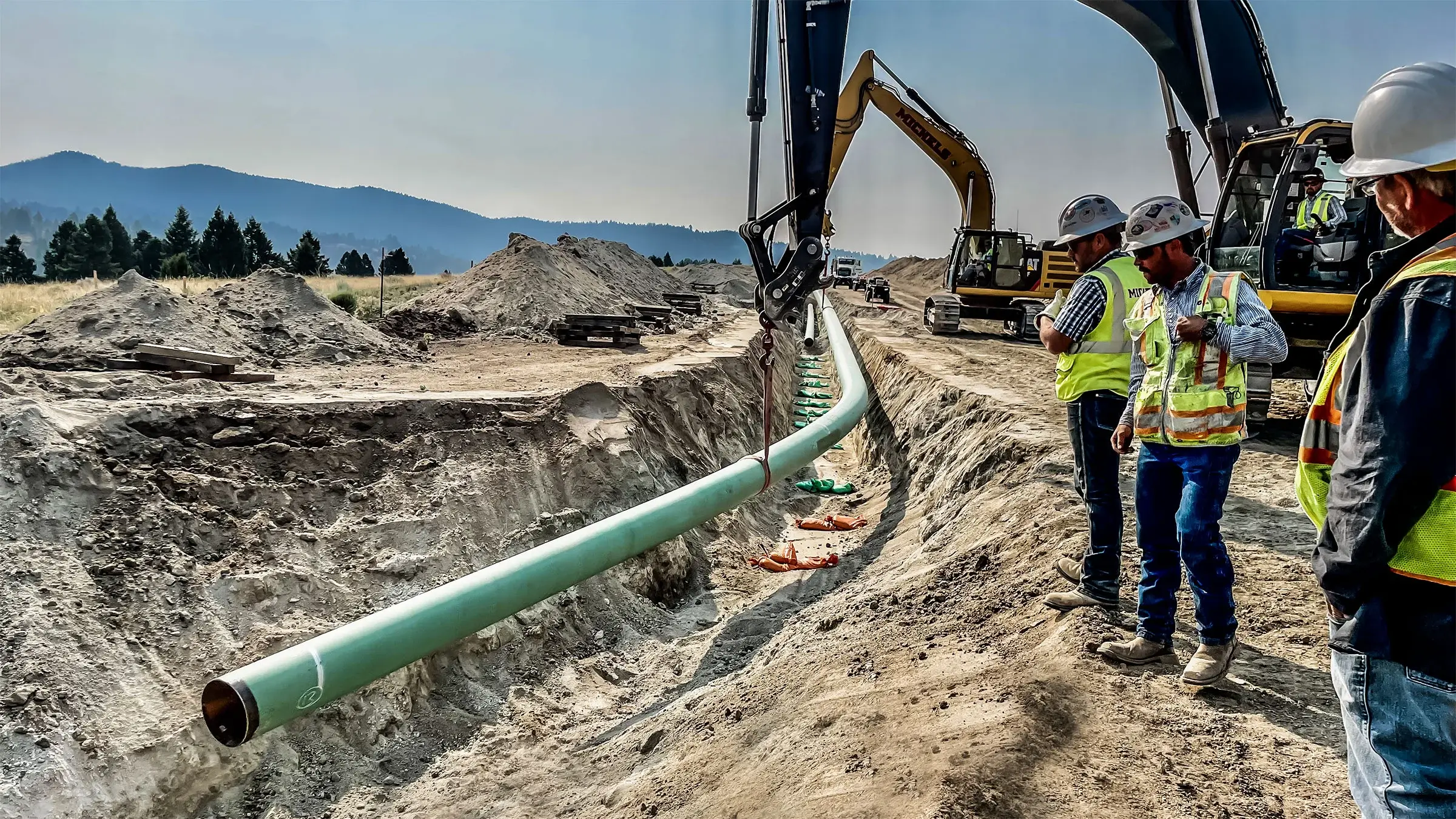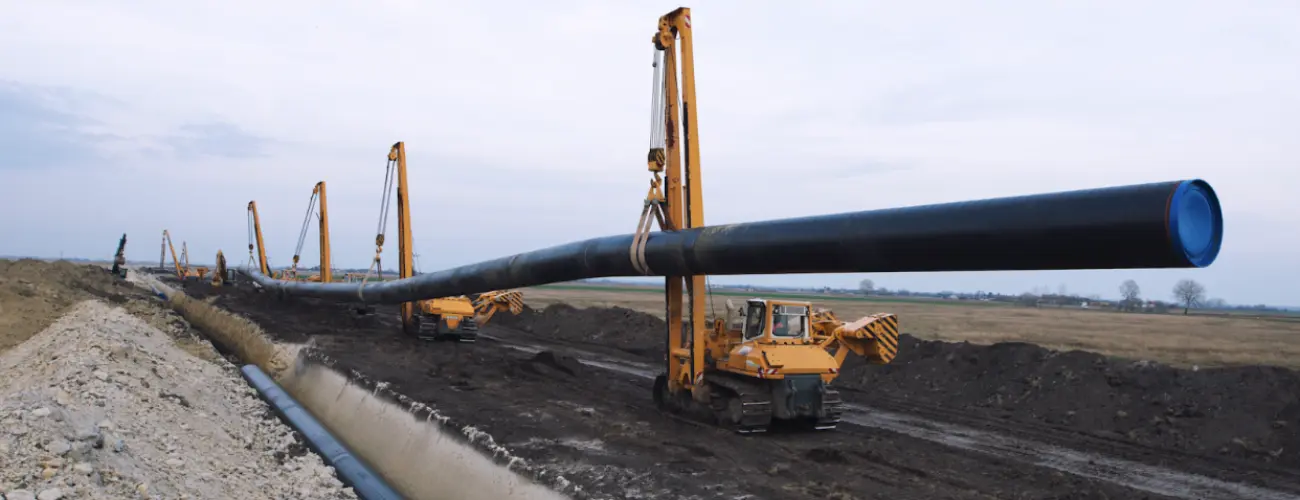The Environmental Impact With Creek Pipe HDPE installation Techniques
The Value of Pipeline Construction: Exploring the Providers Offered in the Market
Pipeline construction is a vital part of modern infrastructure. It facilitates the transport of crucial resources like oil, gas, and water. The sector includes numerous services, consisting of planning, website preparation, and installation. Each stage needs accuracy and adherence to security standards. As communities rely on these systems for their livelihoods, comprehending the complexities of pipe construction exposes its significance and possible difficulties. What factors affect the success of these projects?
Review of Pipeline Construction Services
Pipeline construction solutions encompass a variety of specific tasks created to promote the installation of pipelines for delivering different substances, including oil, gas, and water. These services usually consist of site preparation, excavation, setup of pipeline sections, and backfilling. Knowledgeable labor and innovative tools are essential for guaranteeing each stage is executed with accuracy and safety.Safety methods are extremely important, as these tasks often entail collaborating with unsafe products and in tough settings. Quality assurance steps ascertain that the pipelines meet market criteria and regulations. In addition, the solutions may involve trenchless technology, which reduces surface disruption.Environmental considerations play a significant role in pipe construction, needing evaluations and reductions to protect surrounding environments. On the whole, pipe construction solutions are necessary for establishing the infrastructure essential for energy and water distribution, sustaining both financial growth and societal demands.
Planning and Design in Pipeline Projects
Effective planning and layout are crucial elements of successful pipe tasks, making sure that all facets are meticulously attended to before construction starts. This stage involves thorough usefulness studies that analyze the technological, economic, and ecological aspects influencing the job. Engineers and designers team up to create in-depth plans that describe the pipe course, materials, and construction methods, straightening with regulative needs and industry standards.Advanced software program and modeling techniques are typically utilized to imitate various situations, optimizing the layout for performance and safety. Environmental influence assessments are conducted to alleviate possible harm to communities and communities, mirroring a commitment to lasting practices. Furthermore, stakeholder involvement is essential, cultivating communication and addressing worries from affected celebrations. Inevitably, effective preparation and style set the foundation for a pipe task, lessening risks and ensuring a streamlined construction process, eventually adding to the general success of the operation.
Website Prep Work and Excavation
Extensive website prep work and excavation are essential steps in the pipeline construction process. This phase involves a comprehensive evaluation of the land where the pipeline will be set up. Job teams carry out surveys to identify soil types, topography, and existing energy lines to guarantee a risk-free and effective excavation. Correct site preparation lessens environmental impact and promotes smoother construction operations.Excavation adheres to, where hefty machinery is employed to remove dirt and rock, producing a trench that satisfies the defined depth and size for the pipeline. This procedure has to follow safety policies and environmental guidelines to protect against damage to surrounding ecosystems.Additionally, disintegration control actions are applied to stabilize the website during and after excavation. Effective website preparation and excavation contribute substantially to the total success of pipeline tasks, laying a solid structure for the subsequent phases of construction.
Pipeline Installation Strategies
Pipeline installation methods are important for the successful implementation of infrastructure projects. Two popular methods consist of trenchless modern technology, which decreases surface area disturbance, and the open-cut excavation procedure, understood for its simple approach. Each strategy supplies distinct benefits and factors to consider depending upon job requirements and ecological elements.
Trenchless Modern Technology Approaches
While typical techniques of pipeline installation often include considerable excavation, trenchless innovation techniques supply a more efficient and eco-friendly option. These cutting-edge methods, such as horizontal directional exploration and pipe bursting, minimize surface area interruption by enabling the installment of pipes without substantial digging. This not just decreases the ecological effect however also greatly cuts down on labor and reconstruction prices. Trenchless approaches facilitate the installation of pipelines in metropolitan areas where typical excavation would be unwise or harmful to existing framework. Additionally, these techniques can fit different dirt kinds and problems, making them versatile options for pipeline construction. Eventually, trenchless technology stands for a substantial improvement in the pipe industry, promoting sustainability and functional effectiveness.

Open-Cut Excavation Process
Open-cut excavation stays an essential technique in pipeline installment, characterized by the direct excavation of a trench to lay pipes. This technique includes eliminating dirt and various other products to develop a trench of sufficient depth and width, enabling the placement of pipes at the required quality. Open-cut excavation is often liked for poly gas line its cost-effectiveness and simpleness, specifically in locations with secure soil problems. Nonetheless, it can interfere with surface area activities and requires careful planning to manage web traffic and environmental effects. Safety procedures must be implemented to protect employees and close-by facilities throughout the excavation procedure. In general, while open-cut excavation might not be appropriate for all terrains, it continues to be a commonly used strategy in pipeline construction.
Checking and Top Quality Guarantee
Checking and quality control are vital elements in pipeline construction, guaranteeing that setups meet recognized security criteria and efficiency requirements. Numerous examination methods and approaches are utilized to analyze worldly top quality and adherence to regulatory conformity. This methodical approach aids identify possible issues before they intensify, guarding the integrity of the pipeline system.

Assessment Techniques and Techniques
Inspection methods and techniques are important parts in making certain the integrity and safety and security of pipeline construction. Various methods, consisting of aesthetic assessments, ultrasonic testing, and radiographic exams, are used to find issues and confirm quality. Aesthetic assessments permit the identification of surface abnormalities, while ultrasonic screening makes use of acoustic waves to analyze wall surface thickness and locate problems inside. Radiographic evaluations involve X-rays or gamma rays to create images of the pipe's structure, exposing covert concerns. In addition, stress screening is performed to evaluate the pipeline's integrity under operational conditions. These methods collectively add to a complete understanding of the pipe's condition, enabling timely maintenance choices and guaranteeing conformity with market standards. Efficient inspection is vital for protecting against failures and promoting long-term operational security.
Security Specifications Conformity
Making sure conformity with safety and security requirements is critical in pipe construction, as it directly try these out impacts the task's total top quality and integrity. Sticking to well established regulations and standards assurances that construction practices alleviate threats associated with pipeline installment and operation. Creek Pipe HDPE installation. Extensive screening procedures, including non-destructive screening and pressure analyses, are critical in verifying that pipes can endure the functional stresses they will certainly come across. Quality control measures are additionally necessary, as they establish a structure for constant tracking and evaluation throughout the construction procedure. By prioritizing safety and security criteria compliance, companies not only safeguard workers and the setting however also boost the honesty of the pipeline, inevitably leading to lasting operational success and public depend on in the facilities
Material Top Quality Assessment
Product high quality evaluation plays a considerable duty in the total stability of pipeline construction. This process involves extensive screening and quality control steps to ensure that products fulfill market requirements and specifications. Numerous tests, including tensile stamina, corrosion resistance, and weld integrity analyses, are conducted to determine any kind of prospective weaknesses. A comprehensive assessment not only guarantees the efficiency of the pipeline yet also improves safety and security and toughness over its lifespan. Additionally, carrying out high quality control procedures assists mitigate risks related to product failings, which can result in expensive repair services and ecological hazards. By prioritizing material high directory quality examination, business can ensure conformity with regulative requirements while promoting self-confidence amongst stakeholders in the dependability of their pipeline systems.
Repair And Maintenance Services
Maintenance and repair services play a necessary function in the long life and performance of pipe systems. These solutions encompass normal evaluations, repairing, and restorative actions to deal with deterioration, leaks, and other issues that might emerge with time. Skilled professionals utilize innovative innovations such as ultrasonic screening and smart pigging to keep track of pipeline integrity, ensuring that any type of potential troubles are recognized early.Additionally, maintenance programs typically consist of set up safety nets designed to enhance system integrity and reduce the possibility of unexpected failings. Repair services might include the replacement of broken sections, securing leaks, or using trenchless innovation for minimal disruption.
Environmental Conformity and Precaution
Pipeline systems not just need recurring repair and maintenance to operate successfully however likewise must comply with stringent ecological compliance and precaution. These guidelines are vital for decreasing ecological effect and making sure public safety and security. Business in the pipe construction industry apply complete environmental evaluations prior to project initiation, recognizing potential dangers to wild animals and ecosystems.Furthermore, adherence to safety procedures secures employees and surrounding neighborhoods. This consists of regular training on emergency situation feedback and spill avoidance techniques.To maintain compliance, markets use keeping an eye on innovations to identify leakages and various other abnormalities in real-time. Ecological management plans are usually developed to describe actions for resolving unforeseen issues during construction.Ultimately, strict adherence to environmental compliance and security actions not just meets lawful obligations however likewise promotes lasting methods within the sector, advertising an equilibrium in between framework development and environmental stewardship.
Frequently Asked Concerns
What Job Opportunities Are Available in Pipeline Construction?
Career opportunities in pipeline construction encompass duties such as project supervisors, engineers, welders, and security examiners. These positions require varied abilities, offering paths for development in a vital field of framework advancement and power distribution.

Exactly How Do Pipeline Projects Effect Citizen Communities?
Pipeline tasks substantially affect local areas by influencing economic growth, providing task opportunities, and enhancing facilities. They might likewise elevate concerns concerning environmental impacts, land usage, and potential interruptions to community cohesion and all-natural environments.
What Technology Is Utilized in Modern Pipeline Construction?
Modern pipe construction uses innovative technologies such as GIS for mapping, drones for airborne studies, and automated welding systems to enhance performance, safety, and accuracy, inevitably assisting in the reliable transportation of resources throughout different terrains. Creek Pipe reviews.
How Are Pipeline Construction Expenses Estimated?
Pipeline construction expenses are approximated via comprehensive assessments of materials, labor, devices, and regulative demands. Aspects like surface, task size, and environmental considerations likewise greatly influence the overall budget plan and monetary preparation for construction.
What Are the Largest Challenges in Pipeline Construction Projects?
The most significant difficulties in pipe construction tasks include regulatory conformity, environmental concerns, logistical problems, safeguarding funding, and managing labor shortages. Each variable can significantly affect timelines and budget plans, making complex the general execution of the job.